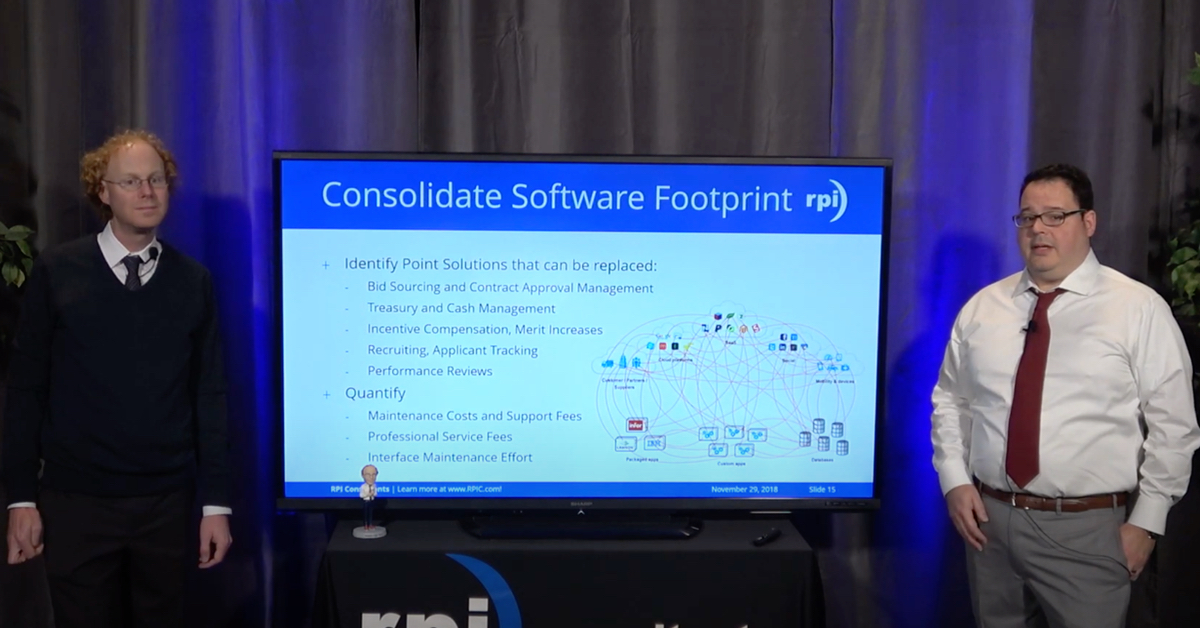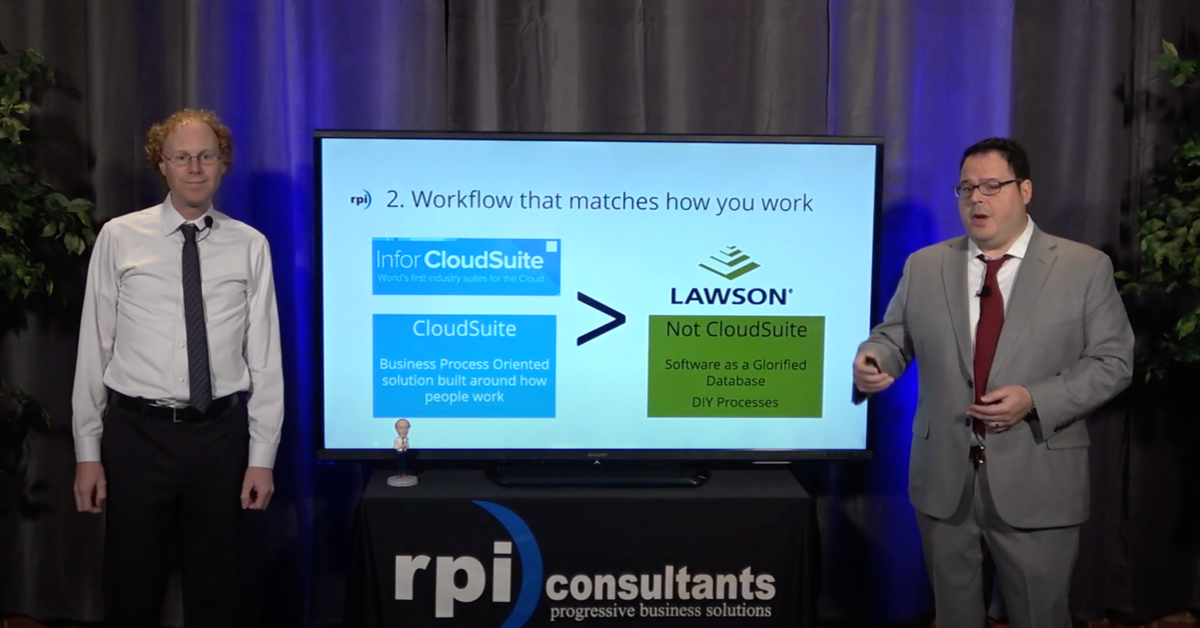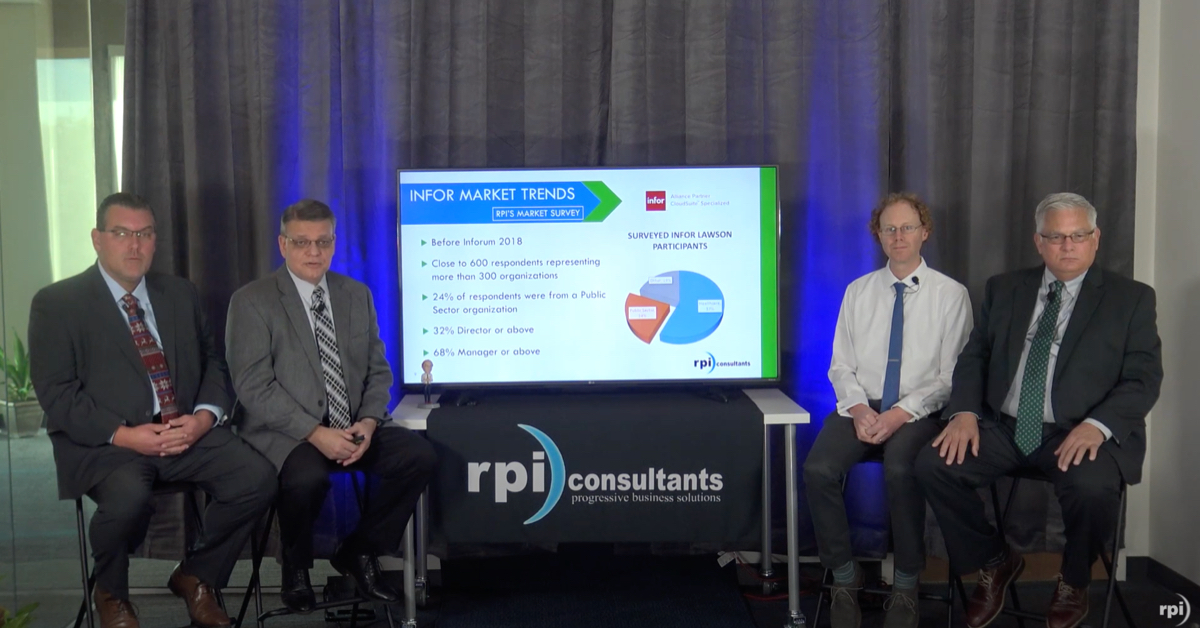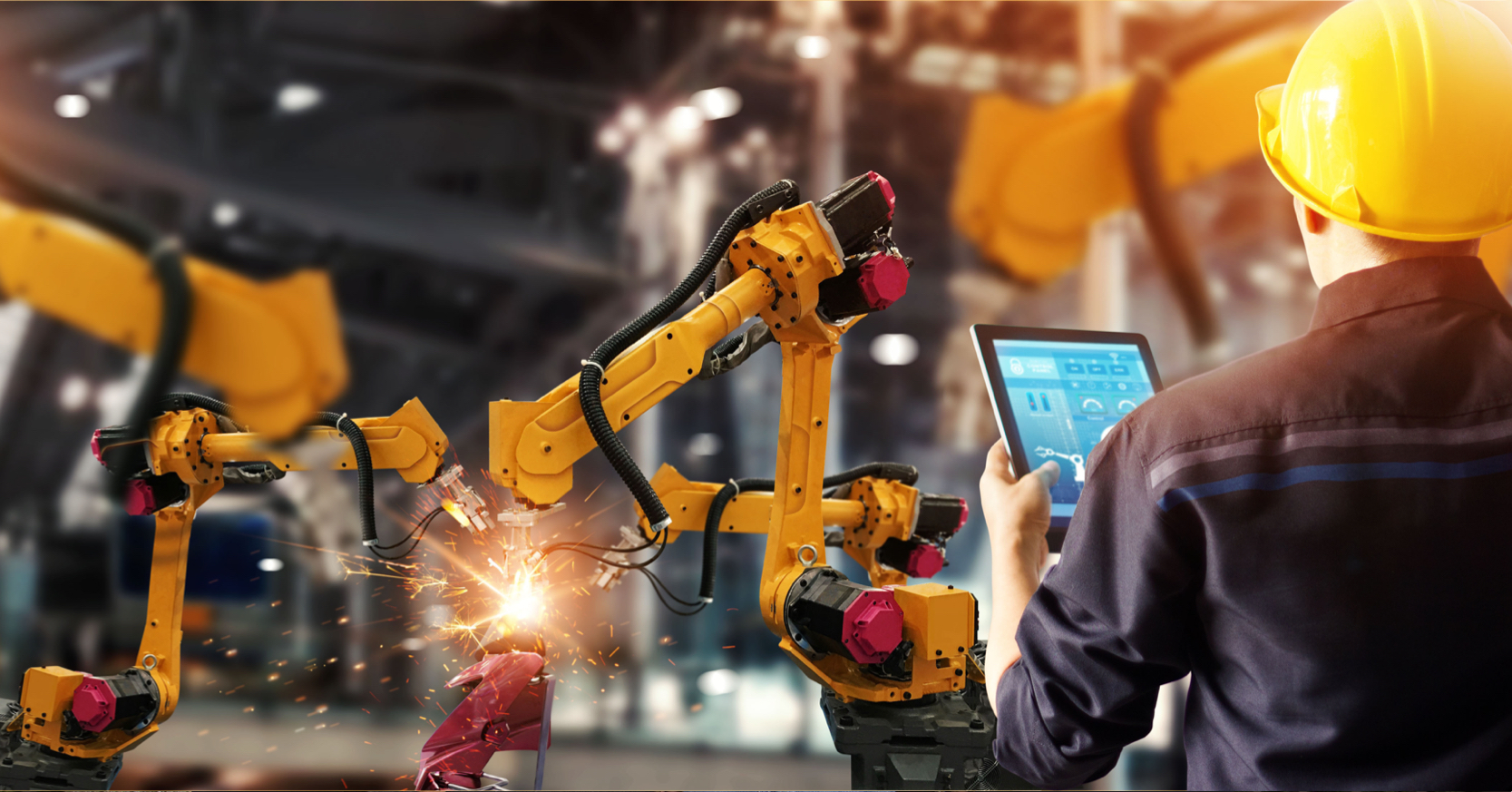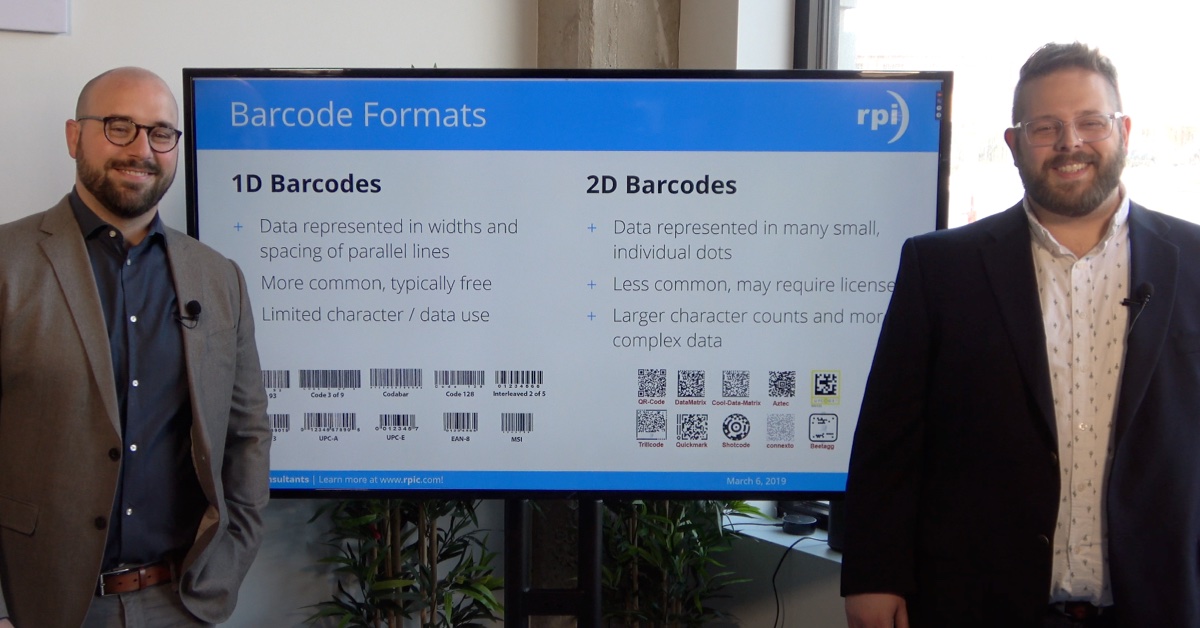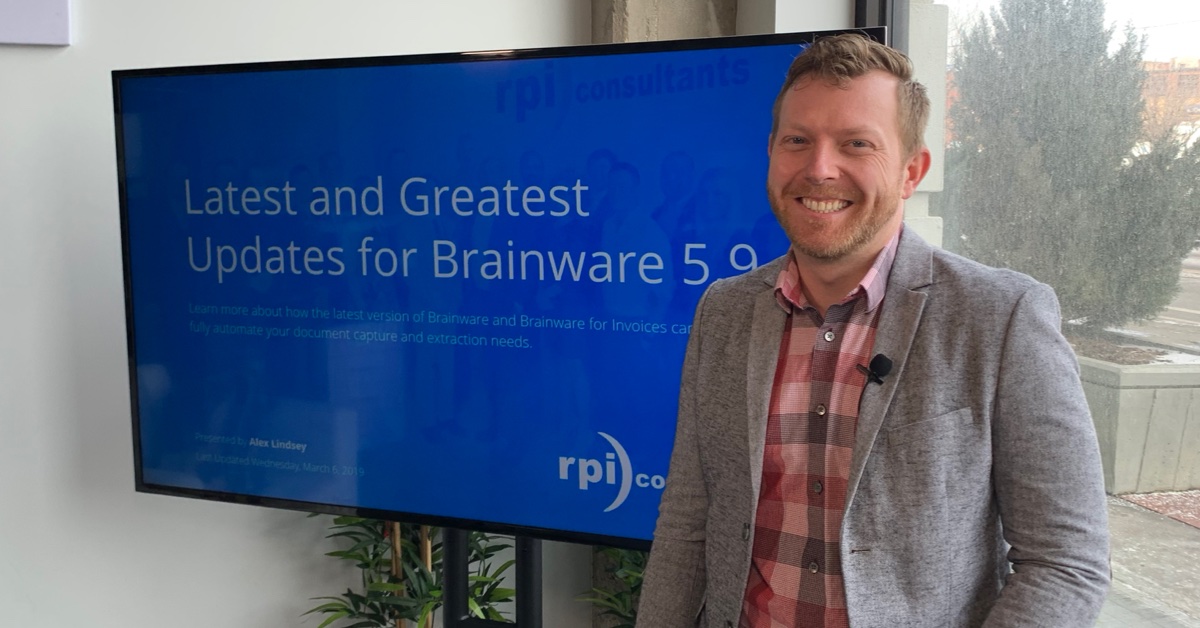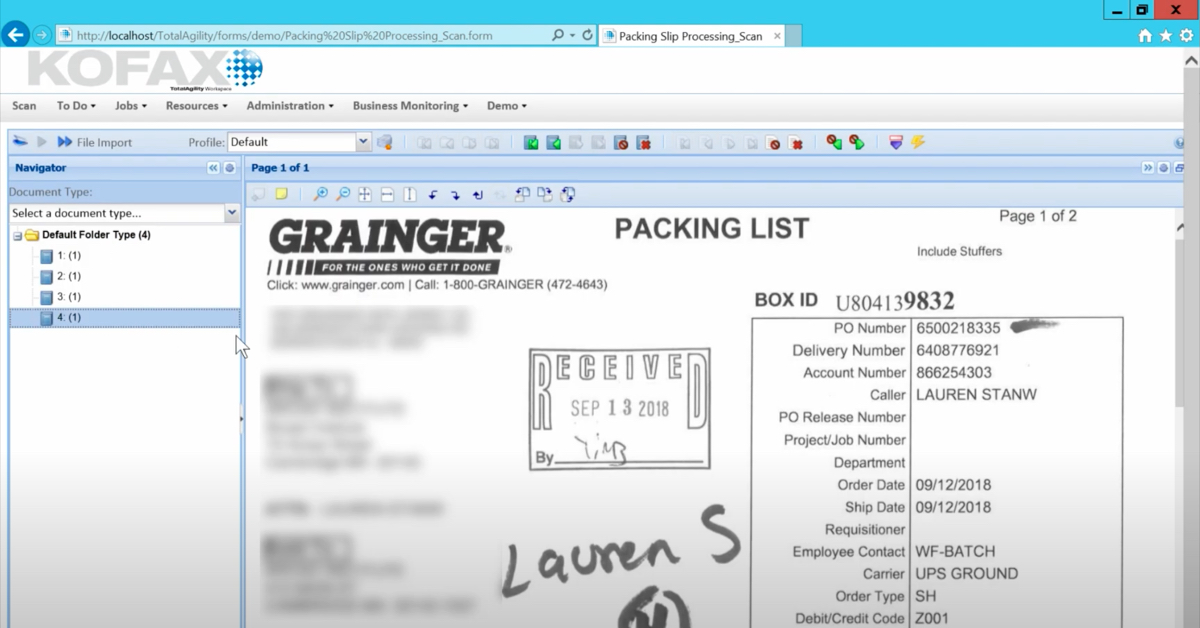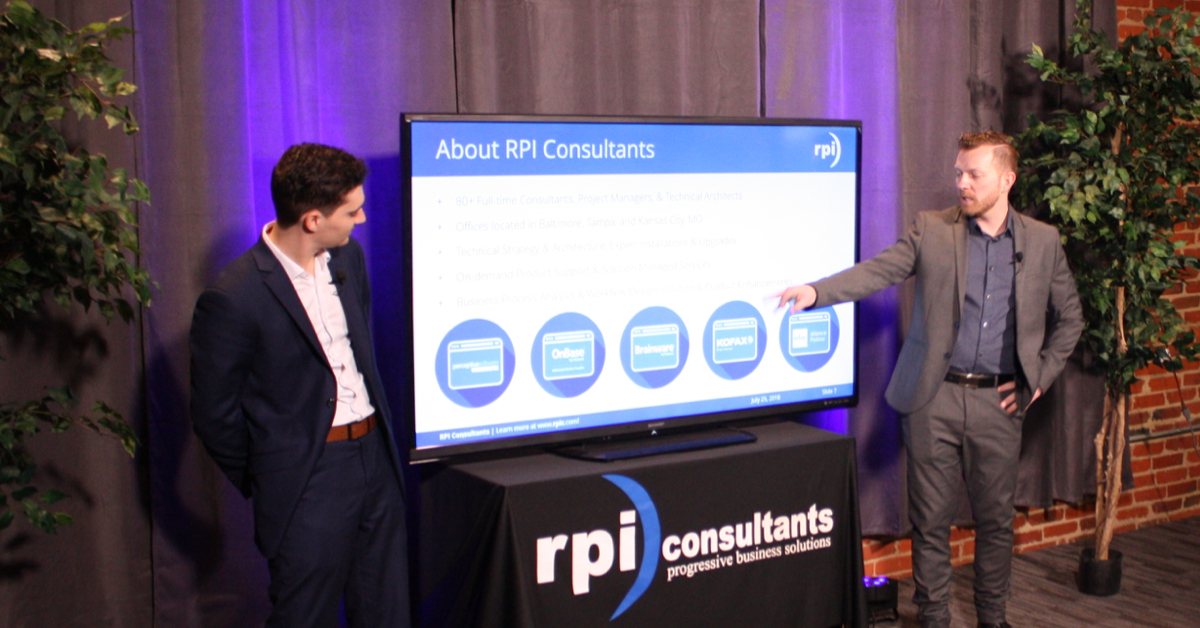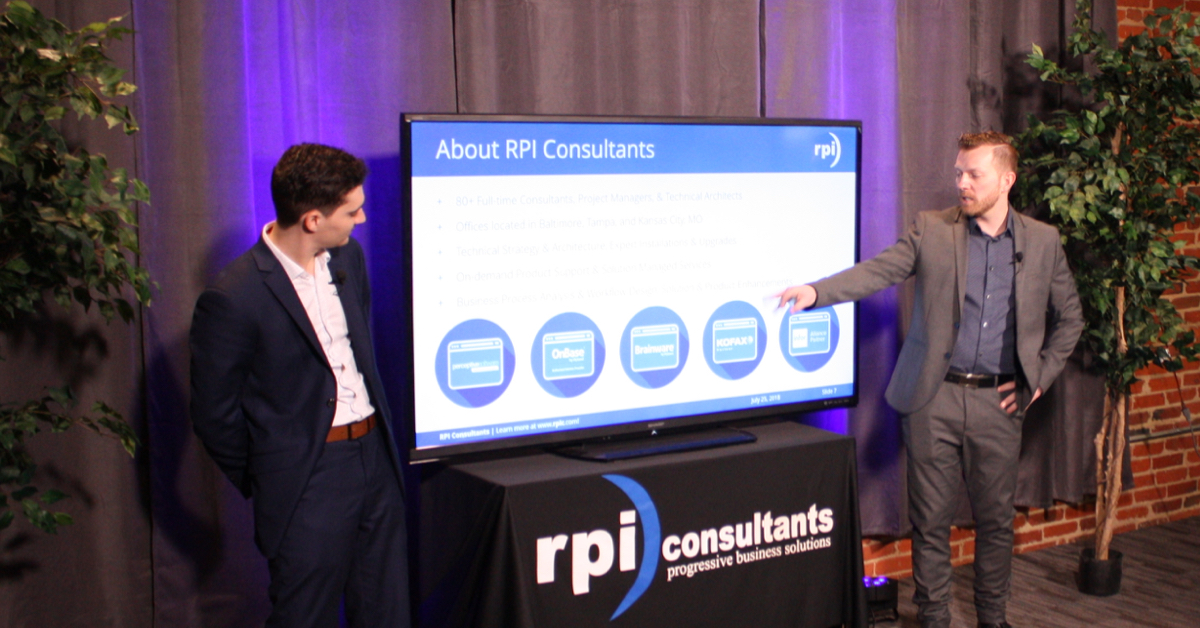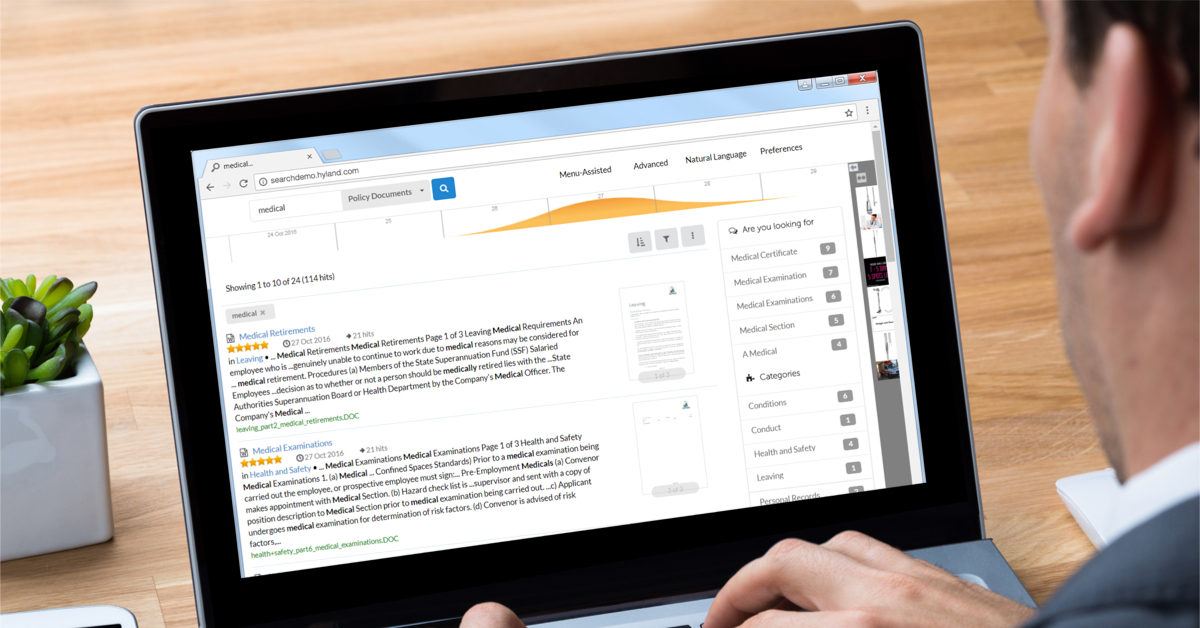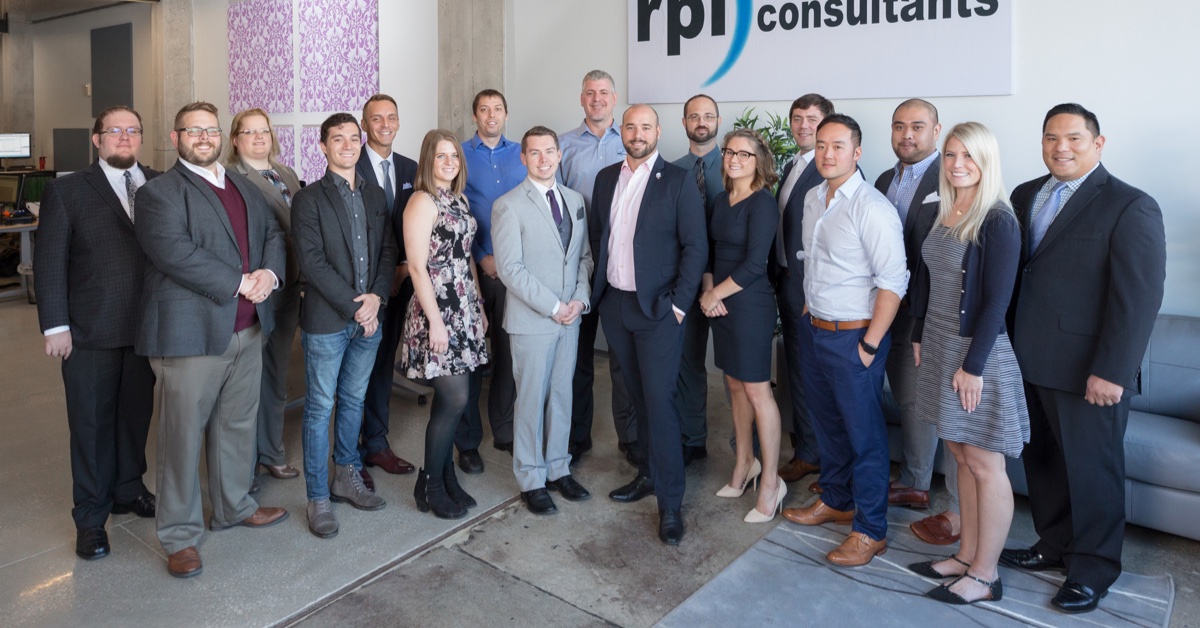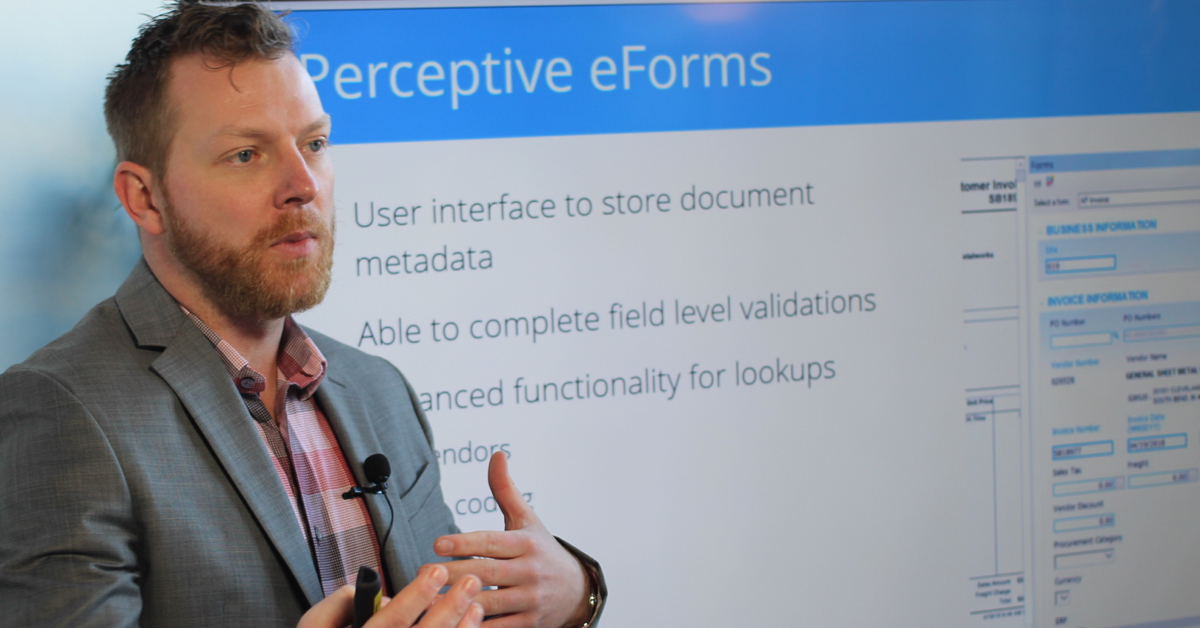Kofax RPA for Accounts Payable
Kofax Robotic Process Automation (RPA), also known as Kapow, is an easy-to-use platform that allows you to quickly set up software robots to replace manual tasks, decisions, and activities. When applied in Accounts Payable, Kofax RPA can automate manual tasks and processes around new vendor setup, invoice exceptions, and payment processing. Accounts Payable Automation with Kofax RPA reduces costs, delays, and errors.
Transcript
Quinn Huntsman:
Well hello everyone. Welcome to another Webinar Wednesday with RPI Consultants. Today we are going to be discussing accounts payable automation with Kofax RPA, which stands for robotic process automation, formerly known as Kapow, and how it can extend beyond your typical invoice processing solution.
A few housekeeping items here before we get started. First, I want to let you know that this presentation will be recorded and posted online. Additionally, there will be an opportunity later on in the presentation for you to ask questions, so if you do have questions or any future webinar ideas, be sure to let us know at that time.
So before we get started, to tell you a little bit about ourselves, my name is Quinn Huntsman. I’m a business analyst here on the CPA team here in Kansas City, Missouri. I have a background in administration and troubleshooting for perceptive content and the other products that come along with that from Hyland as well as I am a certified technical solutions specialist for Kofax’s RPA product that we’ll be talking about today. For a fun fact about me, I’m a huge Queen fan.
Bryant Bell:
Great, thanks Quinn. My name is Bryant Bell, and I am the Senior Director of Product Marketing at Kofax. I have about 20 years of enterprise content and data product marketing and management experience. I’ve worked at companies such as EMC, Adobe, Documentum, and also OpenText. Now I work at Kofax.
Some of the areas that I’ve had concentration with in my career are governance risk and compliance, legal, document automation, machine learning and predictive analytics. And a fun fact about myself is that I have actually sailed a sailboat to Cuba, and I actually did that on purpose, and it was a fantastic, fantastic trip. So thank you, Quinn.
Quinn Huntsman:
All right, on the agenda today, to get started, we’re going to tell you about Kofax, about RPI Consultants, then we’ll get into the bulk of the presentation to discuss accounts payable automation for invoice processing, and then get a big more granular in how RPA can apply to that. Once we’re done with all of that, there will be an opportunity for you to ask questions and then a summary.
Bryant Bell:
Okay. Great. So, a little bit about Kofax. Some of you have heard of us, some of you may not have, but just to give you a little bit of history about Kofax. Kofax as a software company has been around for over 25 years, and we really started in imaging and data capture. It goes back to our name. There’s fax in the name and that goes back 25 years or more but we have evolved in the last 25 years to really be a software and solutions company that is really looking at how we can help companies transform their business.
We have evolved our capture and imaging into what we call Cognitive Capture and that’s really adding in tools that go past just imaging and tools such as machine learning, that allow the capture technology to actually recognize those types of documents, classify them, and then also pull information out of them. We’ve also had and have for a long time had the ability to do mobile capture. The ability to use our technology to capture checks, capture invoices with a smartphone or really any digital capture device. We also have advanced analytics that we provide and we also have process orchestration which is a product that we call Kofax TotalAgility.
In process orchestration is really process automation for long term or very complex processes. What we’re going to be talking about today is going to be robotic process automation and that’s another area that we provide. But if you look at all these four areas, I mean five, areas of competency that Kofax provides, we really look at being able to provide you automation, process automation and advanced or what a lot of people are calling artificial intelligence to help you manage documents and data from capture through to processing. And being able to not only process those through a process but be able to interface with other applications as well.
So that’s a little bit about Kofax, where we are today and all of our technologies and what we consider ourselves now is as an intelligent automation company.
So with that, I’ll hand it back over to Quinn.
Quinn Huntsman:
Thanks Bryant.
So a little bit about RPI Consultants. We are a full service provider and software retailer for leading enterprise content management systems and business process automation softwares including Infor Lawson, products by Kofax previously mentioned and then the Hyland software suite.
Furthermore, we have 100 plus full time resources including technical and solution architects, as well as project managers, who are ready to add value to your business every step of the way. We are based out of Baltimore; however, we have offices in Tampa, Fl, and Kansas City, MO where I’m presenting from today.
Some of our professional services include technical strategy and architecture, new installations, upgrades and migrations, process analysis, system designs and implementations as well as managed services and staff augmentation. Then we have project and change management services as well. In addition to that, RPI is a proud Kofax Platinum partner which means we are a authorized service provider and licensed reseller for various Kofax products such as Kofax Capture, Transformation, TotalAgility, Robotic Process automation formerly known as Kapow, and ReadSoft Online. Additionally, our solution expertise expands across various industries such as accounts payable and financial process automation meaning invoice processing, vendor document management and packing slip automation. As well as human resources and human capital management.
So now we can go ahead and get into the bulk of the presentation here. First we’re going to provide a bit of a high level breakdown of some of these accounts payable processes that we’re going to be providing some RPA context towards later. So let’s go ahead and get started.
So before we get into how we automated these processes, let’s talk about why. Automating your back office tasks allows you to reduce costs by processing a lot more invoices faster with less overhead involved, allows you to qualify for early payment discounts and avoid any late payment penalties. As well you can reduce human errors and have your employees focus on handling exceptions and improving things like image quality as opposed to working on things that are not, not working as they should. Additionally this allows you to reduce delays by increasing your percentage of straight through invoice processing and getting your vendors paid faster.
So now if you look at the how we do this. There’s a bit of a breakdown, a few sub-processes that we’re able to automate within a more broad AP process. So first there’s a matter of getting invoices in the door with capture import, then we can build solutions to extract data from those invoices whether it’s through OCR or other methods. We can classify those invoices and export them as needed from your system. Additionally we build solutions to handle overall workflow management including exceptions and approval routing, rather. And then we have solutions for various different integrations.
Bryant Bell:
Okay. Thanks Quinn. I’ll take it over from here. But you know, when we start talking about AP automation and especially when you start looking at AP automation and where robotic process automation can help. Got to kind of think about what you can do by automating some of the processes and lots of times when we talk about RPA we talk about tasks. As you know, through the full process of Accounts Payable processing and handling with, inside an organization there’s many different tasks that you have to handle.
And a lot of these tasks you can string together with RPA. But really before I start diving into this, I want to give you a frame of context around what is RPA.
So, in this specifically when we talk about RPA for Kofax, this is definition and it really gives a good perspective about what robotic processes automation is. Sometimes we walk in and we talk about, “Hey, you know, we can build you robots that help you automate your AP processes.” And people look at us and say, “Hey, we don’t want a robot standing over our shoulders.”
And you know what, with robotic process automation, this is software. It’s not an automatron that’s going to be helping you. It’s actually software that sits on top of your current applications to add automation between all of them. So, with Kofax RPA…Kofax RPA is configurable software. Which means that this is really… it’s out of the box software and it comes with built-in functionality. Some of the built-in functionality that it has…it has what we call cognitive document automation which allows you to recognize documents, classify documents, and for us that’s really looking at invoices, purchase orders, purchase reqs, things like that.
And it comes right out of the box and really all you have to do with it is tell it what to do. Well how do you tell it what to do? Well, with Kofax RPA it uses business rules to know what to do. A lot of times these are your set down processes of how you process your accounts payable. So these business rules really determine how a software robot will execute. The other things that determines these business rules is those processes of how you interact with your other applications and other data repositories for collecting your data for your AP processes. And then the next thing you have to look at is your sequences of actions.
You have your processes, your business rules, how you carry out those rules and these are the steps taken to complete those actions that are really detailed in your rules. And with RPA, RPA can handle sequences ranging from very simple tasks, such as creating and updating reports, consolidating information, and I’ll get into this later, into your automated clearing house reports. Your ACHs and getting those taken care of for you as well. And then can do very complex tasks as well. These are all things that can happen automatically. So once you configure the software robots, all you have to really do is give it a trigger and it’ll go off and do those.
There’re two different types of robots that we usually talk about. There’s attended robots that you’re interacting with pretty much on… They finish a task, they come back and they ask you, “What do you want me to do next?” And then you tell it what you want it to do next. Then there’s unattended, which are really… we talked about the sequencing, they’ll follow a sequence through in an unattended process. They’ll tell you about exceptions, but once they’re through with a certain process they’ll wait for another trigger and that trigger might be when you’re working in your finance program. It might be a keystroke, it might be part of your workflow and when an invoice comes in. A robot will recognize that and start working off of that.
Now the other thing here too is that RPA, since it sits on top of applications and isn’t integrated into applications, and is not another heavy application that you load into your servers. It’s really has the ability to interact with pretty much any application you have. And this becomes very important when you’re really talking about a robot taking over some of those really manual tasks that humans do. If you look at this whole definition, Kofax RPA is a configurable software, uses business rules and sequences of actions that automatically complete processes, typically human processes that are routine, in any number of different applications the same way a human would. And then with the help of people for exception management. And you’re going to see some of the benefits that Quinn talked about before. This is where Kofax RPA can really help.
So if you can, from your employees, take away a lot of those routine tasks, cutting and pasting, keying in information from say a digital copy of an invoice into your ERP system, things like that. If you can take that away from the humans that are working, you’re actually freeing up time for them to do things that are more valuable for your organization.
Quick Story. One of our customers, we came in, introduced RPA into their AP department, they implemented it, they came back and told us… they said hey look, “This has been fantastic. We’ve actually hired two more people into our AP department and the reason why is that we’ve found out that we’re able to process invoices faster. We’re being more productive, but what we’re really hiring the people here for is that we’ve found out that we can handle the exceptions and be much more customer facing and really work with our customers to have better customer service through the AP department.” And this is something that we see in a lot of our organizations.
So lets get down to where RPA can really help and start talking about first couple things. It’s really how do you process those invoices, where do you get that information? And this has been a real challenge for many of our customers when their AP departments have been around for a while, they have their processes down but they’re working with multiple different applications and then they’re also working with, “How do I get this information that I need off my invoices?” And they’re receiving invoices sometimes through EDI, sometimes via PDF, sometimes they have to go to a digital lockbox and pull down invoices from that location as well or multiple locations.
They’re also dealing with multiple different types of invoices depending on what they’re selling. So, we’ve heard from some AP departments that even though they give a certain email address to certain types of vendors, sometimes the vendors mix their invoices so they get multiple different types of invoices coming into one email inbox and it’s all mixed up and the only way they can solve that is via manual process of pulling all those out. Well this is really an area where robotic process automation can help.
So if you look at your lockboxes and you know that we need to go and retrieve invoices out of the lockboxes twice a day or three times a day or you can even schedule it once a day, but you know that tends to be a manual process. And then you go in that lockbox and then you have to start separating out invoices. Well these are all things that once you design a robot, that robot can do that for you automatically. You can schedule it to go into the lockbox, the robot is… actually you can design it to recognize the different types of invoices in there, separate them out and push them onto where they need to go next in the process.
We have a large healthcare provider that does this on a daily basis. They have multiple clinics that send their invoices into a lockbox and they have to go up there and pull those down multiple times a day just to keep the processes going. And they do this all with RPA. Another thing that really happens here as well is that a lot of companies now are using readable PDFs for their invoices, mainly because they want to keep a true image of the invoice. They’re finding that’s a more secure way to send the information. Likewise, I’m sure a lot of you know that invoices are sent using EDI as well. Same problem exists here as well. You might get invoices in PDFs in batches, EDIs, you have to separate those as well. And these that can all be managed with robotic process automation.
So, let’s go onto the next thing. We’ll talk about EDI mapping a little bit more.
So, when you’re looking at EDI mapping, it’s really what you’re looking at is you’re looking at a data string and sometimes all the information in that data string through EDI doesn’t get in there. But you’ll have an invoice number and you might be missing a PO number, you might be missing some other critical data. So then what you do is you take that invoice number and then you have to go to another system, look it up, match them up, and then add information into that. And here we have the example of you need to visually match a printed check, you might have to match a purchase requisition or a po as well depending on what’s there. I’ve heard sometimes through EDI, sometimes the vendor information doesn’t come through correctly all the time so they’re matching up that as well.
With that, that’s a huge challenge. You can see that in there, there’s a lot of time that you have to do it manually. There could be a lot of errors as well. This is another area where RPA can really help with this. RPA can… you can schedule an invoice release schedule with EDI based on based on specific criteria and conditions. You can do that data validation. Here against a digital check image and you can attache a check image but you can also do the data validation and also have data that is replaced and augmented with.. augment the incomplete data with the correct data and RPA can do that as well. And one of the things that RPA is very good at is once it has all this information it can compile this information and then create reports and for here in this example RPA can automatically compile and deliver those clearing house flat files that you need to go through your into your clearing house to get those transactions taken care of.
And that is something that can be produced with RPA. So you design a robot, the robot can do that for you and the benefits there is that A. It’s extremely fast, since it’s a robot and it’s pulling the data off your EDI streams to make this happen and you’re not keying it in or copying and pasting, it’s going to be error free. So it’s going to reduce those exceptions, reduce errors, and overall reduce your costs as well. So that’s a little bit of EDI mapping. Along with, lets see, with invoice processing here some of the challenges we have here, I’ve talked about some of them already, but some of the big ones are being able to classify and extract invoice data from invoice images and then also code those invoices as well.
Like I talked about, even though you try to have processes in place where invoices are coming into a specific email inbox or really into those digital lockboxes, lots of times it doesn’t happen exactly as you plan it to. Some vendors either get lazy or they forget about the procedure and so what you end up doing is you have a batch of invoices that then you need to manually classify and code. The other thing too and I mentioned this before is purchase order and purchase requisition data matching. Lots of times in processes this is manual as well to match those up and also get approvals on those and then do your approval routing.
So if you look at this, what RPA can really help with is RPA can go in to, and I’ll use the email inbox for example. It can go in and look at those batches of invoices and with our OCR and transformation capabilities that we have the RPA system can actually start to classify and match out those invoices into the different invoices and once it gets classified it can actually code those batches for you. And this is some of the technology that we have with machine learning and with Kofax RPA and the transformation management the first step in machine learning is really looking at those batches. They’ll look up and match like invoices to like invoices and as it’s learning it’ll come up and say, “All right, here’s twenty invoices. They all look the same, they have similar information. How do you want them coded?” And then the next time it goes through, it’s not going to ask you to code it because you’ve already told it now if an invoice looks like this, has all this information, it will get this code and that’s really the machine learning part of it.
It’ll also ask for exceptions when something doesn’t fall into a certain category. Once it gets the code there then it becomes part of it’s overall learning. So over time the exceptions from machine learning and the extraction of the invoicing gets faster and faster. And more and more accurate. So RPA can classify those invoices that come in. Not only can it classify them but with our advanced OCR technologies it can extract the data, and pull that data out and push that data into your other systems. Whether that’s an ERP system, or a separate financial system that you have that you’re using for your AP and AR. It can also match the PO data and then if you want to match it up with an approval matrix based on the amount of invoices it can do that as well. There’s somethings outside of the approval matrix or it knows that it needs to go to somebody for manual approval further along in the workflow, it can do that as well. So those are all the things that RPA can do when it comes to invoice processing.
Quinn Huntsman:
All right so next we have another scenario here where RPA is able to provide some automation for your AP process and that is vendor maintenance. So a few challenges you might face regarding vendor maintenance are when there’s a new vendor that must be set up. Whether that’s in your ERP or wherever, so that you can get invoices processed against that vendor or if you have an existing vendor where you need to update some information such as there’s an address change or a merge or acquisition, what have you.
So the way RPA can help here is that it can automatically perform some of that vendor due diligence to make sure that these are legitimate vendors before you get them into your system. And the way it can do that is by… essentially just querying whatever resources you point it to, so for instance, Google even. [Dun and Bradstreet 00:29:45] is a good one or tax ID verification through the IRS website. There’s a lot of different examples there. And some of that’s in data we can go and get from the internet or whatever other resource we can then use to also go and update existing vendors when there’s changes that need to be represented.
So here is just an overview of a robot that we actually built that does this. The vendor verifier robot, if you will. At a high level it does the same thing four times, so the first step we are searching Google and if you break that down a bit is what we’re doing is taking a user input for the vendor name, we are executing a Google search with that and then we’re storing those results into a screenshot. There’s a lot of ways you can get that information back to the end user, but just with this example, what we’re doing is writing it to the desktop in a PNG file. So again, we repeat that process for a resource such as the OIG, the system for awards management and then the IRS with tax ID matching.
Over here on the right what we’re seeing is a screenshot of what’s called a caplet which is sort of a user friendly interface for a robot deployed through what’s called the management console. Which is an online portal where you can administer some of your robots and that sort of thing. But the benefit here is that an end user can just go to a url, they can take their vendor name like you see here for example The American Red Cross, it can can throw that in the search for a requirement there and hit start and then what the robot will do is write the results back as long as they know where to go look for the screenshot or however you’re getting that data back to the user. It’s a really user friendly way kind of test that due requires are input. It’s a really user friendly, easy way to get that done.
Bryant Bell:
All right so I want to spend talking about legacy system integration for this slide and then also next slide, I’m going to talk a little bit more about what you can do with legacy systems as well. But what we’ve really heard from a lot of our customers, especially when they pull on new applications to help with their finance processes either in AP or AR is that they still have legacy systems that have information that they have to access. And sometimes what they hear from vendors is, “Hey, you know you have that legacy system, we don’t have a connector, we don’t integrate with that. We don’t know the APIs. They may be too complicated for us. Or wow that’s on an old system 36, we have no experience with that whatsoever, so we can’t really help you do look ups from your current system, you’re going to have to exit your current system, go into your legacy system, pull that information up. Maybe create a report to get it out, and then you’re going to have to look at that report and get manual information off that report.”
And the other is too, going the other way, is well we’ve had some customers that have a legacy system that is their system of record. And even though they have new systems that they’ve purchased and have been in production for five, six years, they still have a 20, 25 year old legacy system that’s their system record. And to get that information in they’ve either had to have really expensive integration done, connectors built, things like that or what they do is they’ll just manually key it back into that system.
You can see this can be very time consuming. It can also be pretty much error prone. The other thing that happens is that when and if you have to get audited, I know some of you might get audited once a year, and if you’re highly regulated maybe more so, but if you have legacy systems and modern applications that don’t have a way to talk to each other very well, that’s going to take time and possibly because of the way you’ve been managing it there’s going to be errors in there as well. Which you never want when you’re a highly regulated company.
But luckily, RPA can help with this quite easily. Like I said before, RPA sits on top of your applications and RPA doesn’t rely on APIs or connectors to get into legacy systems. Or to move data from modern systems into legacy systems. It really has the ability to do that type of task, just like a human would. So if you find yourself cutting and pasting from a modern system into a legacy system, that’s something that RPA can do. If you’re printing out a report and then extracting information off that report and then putting it into a legacy system, that’s something RPA can do. And it doesn’t need connectors. It just needs access to both of the systems.
APIs and connectors are always nice. Obviously it makes things easier but with RPA all it needs to know is how do you access that legacy system now to either pull information out of it or to push information into it and it’ll follow that same process. Even if there’s passwords. It can store usernames and passwords and use those usernames and passwords to get in. If it needs special codes, those can be put into the robots as well. It can handle these very quick, very fast and error free as well. And if you’re looking on the slide here, what I described is that Kofax RPA really it does mimic the user’s actions to access the legacy systems and move through the screens. Even if they’re green screens.
There are some companies that are using Citrix to access the legacy systems, Kofax RPA works with Citirx as well so there’s no problem there either. And you can also get RPA to check for duplicates and help clean up some of the things that may be on your legacy system. So that’s a little bit about legacy system integration, it’s very easy with RPA and it’s very cost effective. You don’t have to go through some sort of building of complex APIs and connectors. So onto the next one.
This is something that a lot of people ask us, “You know, hey, I have this legacy system. It’s one of the systems that we use it’s a system of record, has a lot of our old invoice and PO and vendor information on it and some of this stuff is regulated and we need to maintain it but it’s starting to cost us a lot of money. Not only money in just the overall maintenance of an older system.” You can just look at just electricity, maybe the special expertise you need to have for an old AS-400 system. But the applications that are in there as well, you might be into extended maintenance. And sometimes extended maintenance on an old AS-400 system can run 30, 40, 50 percent of what you originally purchased that software for. That gets very expensive over time.
So, we have customers that say, “Hey look, can RPA help us get this information off of legacy system and move it over to our new applications?” And what they’re really concerned about is that data, when it gets moved are we going to maintain data fidelity? We’re not going to lose anything, there’s going to be no degradation in there. One of the reasons that we maintain all this stuff on a legacy system, that’s our system of record and it’s easy for us, say you’re highly regulated or even if you’re own governance procedures say that you must maintain information for a certain amount of time, but you also need to show who’s touched it, when they’ve touched it, basically the chain of custody of how you’ve interacted with vendors, what you’ve sold them. All that critical information, you want to keep it on that system but if you move it over are you going to be able to maintain that?
And also lots of times these legacy systems have enormous amounts of data. Well with RPA, the nice thing here is that instead of going through a huge data migration project. RPA can come in and start moving records over without losing your data. Because what you’re doing is you’re actually telling that robot, here’s all the data that I want to move over, it’s going to come from these fields, it’s going to go into these other fields. And the robot once you design it can do that. And the robot runs 24/7. And it’s a very simple process. It’s actually much simpler than trying to set up, what we call an extract, transform and load type of application that is typically part of a data migration process.
Truly the robot’s doing it for you all the time and if it hits an exception, it’ll log that exception. You can set it up so it sends exceptions into an email box and then you have somebody looking at those exceptions. As soon as they respond to those exceptions, they get sent back to the robot and then it gets put back into the process of that robot to handle that. And so we actually have quite a few companies that use RPA just for this. For decommissioning legacy systems, for data center consolidation, and they’re able to show chain of custody. There’s audit and logging so that if you get audited or an investigation on something, you’re going to know exactly where your documents, where your invoices, who’s touched them, how they got to where they are now, and if there’s anything changed.
And these are all for customers, saves them quite a bit of money. Gets them off those legacy systems. We see this for companies that are moving into the cloud because for RPA it doesn’t matter where it’s going. As long as it has access, it can put it where you want it to go. And one of the things we found out with doing the legacy system decommissioning as well is that you can RPA robot look at that data and say “Hey look, I don’t need any data that’s more than 12 years old. And if it’s more than 12 years old, let’s put it in this low cost archive.” And the RPA robot can do that for you.
And with some of our customers they’ve been able to do this, for example, with the electronic records management systems for hospitals where they’re moving from old multiple systems into the new ERM systems. They’re able to pull over the data that they need and old data they’re able to put into an archive and then they’re able to decommission the old systems. So it’s very efficient and very accurate for our customers to do this.
So that’s it about legacy systems.
Quinn Huntsman:
All right. Thank you, Bryant. So next, we wanted to give you all an opportunity to ask us questions about what we presented on today regarding Kofax robotic process automation. Just a reminder you can submit these questions, if you go to meeting chat and we have a moderator who will feed those questions to us. Please feel free to ask away.
Michael:
All right great. We had a couple come in but again, just go ahead and use the go to meeting interface to drop your questions in.
First one. Can Kofax RPA replace my OCR and data validation solution?
Quinn Huntsman:
So Bryant, I guess we can kind of trade off here. I can speak to this one a little bit.
So RPA does have some built in OCR capabilities and so it’s certainly capable. I guess the decision point, you’d have to kind of weigh which system is a little more fluid and consistent at doing that to make that decision. Bryant, do you have anything to add there?
Bryant Bell:
Yeah. I think the other question you’d have to ask is do you want automation to be part of that OCR and data transformation process? We have really taken for Kofax, it’s really our OCR capabilities and what we call our transformation module and we put those two things as tools that a robot can use. So you’re really not getting the full-fledged, say Kofax capture capabilities. You’re getting what’s necessary to manage images. Somethings that you may not get is image rendering, and de-pixelization. Some of that stuff like that, it can be added on but where this really shines is being able to add in that OCR and transformation directly into an automated process.
Quinn Huntsman:
Great question.
Michael:
All right, next one. Does Kofax help in developing an NLP solution based on data extraction from tables as well as sentiment and text analysis? Assuming the source is a PDF file such as a financial statement or fund performance statement.
Bryant Bell:
That’s a great question. It talks a little bit about where we are going and what I can say is that by the end of this year, that the transformation module that’s part of RPA will have a natural language process included and in there will also be sentiment analysis as well. So we will be able to help with that. We’re looking at it not just from AP automation but also with helping with customer service and also with looking at contracts as well. So it is a function that will be available that will be available by the end of this year. It’s not included right now but it will be.
Quinn Huntsman:
Very exciting things on the horizon.
Michael:
Great. Next question. Can you use RPA to split invoice into multiple GL distribution lines and then send each line to a different manager got approval?
Quinn Huntsman:
Yeah, it’s certainly capable. So there’s definitely some business rules we can create around routing based on the GL information there. Yeah. So it’s certainly a possibility there. Bryant, do you have anything you’d like to add specifically there?
Bryant Bell:
Yeah it’s possible and it’s really…from the data extraction and classifying. So, the nice thing about RPA, you know we talked about it, an approval process where you have a matrix and you can also have part numbers and department codes. It can cross reference tables and classifications, it can do the data extraction, and it can match the data up with those tables and then go on to the next step. I’ve seen some of these robots designed and their actually pretty cool when they get designed. And it’s really taking that one invoice, being able to extract that information, match it up against the matrix and then move it on to where it needs to go to next.
Quinn Huntsman:
That’s a great question.
Michael:
All right, so the next one’s a little long so bear with me and let me know if I need to rephrase.
Given a financial statement that’s containing tables and assuming on that financial statement that there are values we need to extract from those tables, would RPA allow us to create a template with headings for the table or column headers and have RPA extract this data? This is also understanding that the exact placement of the tables may change document to document due to body of text in between tables.
Quinn Huntsman:
So, given that the tables may change as far as positioning there’s some additional… there’s other methods of finding that data that we can approach rather than just setting it to say “It’s always going to be in this row.” So we can use anchors, things like that to find a certain block of text.
There’s lots to handle a scenario where that data’s not always in the same place. There’s a lot more to that question that I’m leaving out there but yeah when there’s data that’s moving around and not always consistent, RPA can definitely handle that.
Michael:
Okay that sounds like a great question. Maybe we can reach out to [crosstalk 00:50:29]. Oh, sorry, go ahead, Bryant.
Bryant Bell:
Yeah and Michael, a lot of this… it gets to the actual functionality that RPA can use. So a lot of this question has to do more with the Kofax transformation manager which is part of RPA. And you can do some very sophisticated things with that application. It can get complex but it goes a little bit beyond my knowledge because I’m not the transformation expert. But this is definitely a question, Michael, that we can get back to them on but really with capture and transformation systems that we have it’s definitely something that we can do.
Michael:
Great. And then another question. Does RPA support project accounting?
Quinn Huntsman:
I guess I want a little more detail around what you do you mean by project accounting in order to answer that. [Crosstalk] we’re building things in a certain way based on projects, just depending on how we design our business rules for the project that can certainly be handled. Bryant, I’ll leave that open for you if you have any more feedback there.
Bryant Bell:
Yeah, and they specified its codes versus GL accounts.
Quinn Huntsman:
Gotcha.
Bryant Bell:
And yes it can. One of the things when I was giving you the definition of RPA, it’s a very much business rules driven. If your procedure is in place it can mimic that procedure, it can look up what your project codes are. If it’s a project that’s going long term, it can manage that as well. And this is one of the areas where RPA can really help on that as well. There’s another area within project accounting that some of our customers that do this use RPA for. They go out and verify that you may be going through projects, you’re doing a certain activity.
Those activities are not only time based, but there’s materials as well, and RPA can go and check to make sure that your sourcing for those materials… You’re getting the best price possible as well. You may have three or four different vendors, RPA can quickly check which is price is the best price and then add the lowest price into your project and make the recommendations for that as well. So there’s a lot of things around project accounting that RPA can help with.
Michael:
Great. Next question. This may be our last one here. Just a quick question on how you go about defining the logic or the robot in RPA. Whether or not it’s GUI driven, or JSON oriented, or does it involve coding using SDK?
Quinn Huntsman:
So a little bit of all of it. For the most part, from building a workflow perspective RPA is mostly a GUI. A very easy interface to work with. But there is opportunity to introduce some custom scripting or JSON, other code to bring some more customization to the solution if that’s how you’re used to doing it. I would say you can accomplish most things through the GUI.
Michael:
Yeah, I’m trying to read the rest of this question on here, but the user interface when you design your robots is the graphical user interface and so you’re actually seeing… up at the top of the user interface something that, if you’re familiar with VIZIO, it’s really helping you graphically design that robot. And the robot can use some of the tools you’re mentioning here. I’m trying to scroll down to the bottom because you asked some questions about Python as well.
We can interface with Python. Matter of fact, there is a…we just launched it. It’s called Kofax Smart Hub which is a market place of ours and we have partners and other users that have already linked up RPA with Python. And they have on the SmartHub, instructions on how to do exactly that. So, I hope that answers your question. A lot of this we can do. If your question is about if RPA is cloud ready, RPA has been containerized, is containerized so it can be put up in the cloud. We don’t offer a cloud version, per say, but a lot of our partners have provisioned RPA in the cloud and it’s running on both AWS and also Microsoft Clouds as well.
Quinn Huntsman:
Well those are some great questions, thank you all for providing those for us. Before you go, we wanted to thank you again for joining us today and mention a two day RPA workshop we have coming up in the Kansas City office hosted by… I’m part of the team hosting it, but it’ll be a great hands on learning experience for RPA where you can kind of throw some [inaudible] cases at us and we can sort of show you how we would tackle those and give you some background information on RPA in general.
So we’re not really marketing this until next week so you’re the first to hear about it. If this is something interesting to you, you certainly want to register as soon as possible. Seating is limited. This will be October 8th through the 9th here in Kansas City. So we’re excited to see you there, don’t forget to register online at rpic.com.
All right, thank you everyone for joining today.
Bryant Bell:
Great. Thank you Quinn. Thank you everybody else.
Quinn Huntsman:
Thank you, Bryant.
Want More Content?
Sign up and get access to all our new Knowledge Base content, including new and upcoming Webinars, Virtual User Groups, Product Demos, White Papers, & Case Studies.
Entire Knowledge Base
All Products, Solutions, & Professional Services
Contact Us to Get Started
Don’t Just Take Our Word for it!
See What Our Clients Have to Say


Denver Health
“RPI brought in senior people that our folks related to and were able to work with easily. Their folks have been approachable, they listen to us, and they have been responsive to our questions – and when we see things we want to do a little differently, they have listened and figured out how to make it happen. “
Keith Thompson
Director of ERP Applications


Atlanta Public Schools
“Prior to RPI, we were really struggling with our HR technology. They brought in expertise to provide solutions to business problems, thought leadership for our long term strategic planning, and they help us make sure we are implementing new initiatives in an order that doesn’t create problems in the future. RPI has been a God-send. “
Skye Duckett
Chief Human Resources Officer


Nuvance Health
“We knew our Accounts Payable processes were unsustainable for our planned growth and RPI Consultants offered a blueprint for automating our most time-intensive workflow – invoice processing.”
Miles McIvor
Accounting Systems Manager


San Diego State University
“Our favorite outcome of the solution is the automation, which enables us to provide better service to our customers. Also, our consultant, Michael Madsen, was knowledgeable, easy to work with, patient, dependable and flexible with his schedule.”
Catherine Love
Associate Human Resources Director


Bon Secours Health System
“RPI has more than just knowledge, their consultants are personable leaders who will drive more efficient solutions. They challenged us to think outside the box and to believe that we could design a best-practice solution with minimal ongoing costs.”
Joel Stafford
Director of Accounts Payable


Lippert Components
“We understood we required a robust, customized solution. RPI not only had the product expertise, they listened to our needs to make sure the project was a success.”
Chris Tozier
Director of Information Technology


Bassett Medical Center
“Overall the project went really well, I’m very pleased with the outcome. I don’t think having any other consulting team on the project would have been able to provide us as much knowledge as RPI has been able to. “
Sue Pokorny
Manager of HRIS & Compensation
MD National Capital Park & Planning Commission
“Working with Anne Bwogi [RPI Project Manager] is fun. She keeps us grounded and makes sure we are thoroughly engaged. We have a name for her – the Annetrack. The Annetrack is on schedule so you better get on board.”
Derek Morgan
ERP Business Analyst


Aspirus
“Our relationship with RPI is great, they are like an extension of the Aspirus team. When we have a question, we reach out to them and get answers right away. If we have a big project, we bounce it off them immediately to get their ideas and ask for their expertise.”
Jen Underwood
Director of Supply Chain Informatics and Systems
Our People are the Difference
And Our Culture is Our Greatest Asset
A lot of people say it, we really mean it. We recruit good people. People who are great at what they do and fun to work with. We look for diverse strengths and abilities, a passion for excellent client service, and an entrepreneurial drive to get the job done.
We also practice what we preach and use the industry’s leading software to help manage our projects, engage with our client project teams, and enable our team to stay connected and collaborate. This open, team-based approach gives each customer and project the cumulative value of our entire team’s knowledge and experience.
The RPI Consultants Blog
News, Announcements, Celebrations, & Upcoming Events
News & Announcements
Mitigating Losses: How Infor Contract Management Protects Your Organization
Chris Arey2023-10-06T16:35:25+00:00October 3rd, 2023|Blog|
What is Expense Management? A Guide for Financial Control
Chris Arey2023-09-27T14:14:06+00:00September 19th, 2023|Blog|
Unlocking Workforce Efficiency With Multi-View Scheduler
Chris Arey2024-02-26T15:12:00+00:00September 5th, 2023|Blog|
Navigate ERP Changes With The Help of a RICE Inventory
Chris Arey2023-08-28T16:39:41+00:00August 22nd, 2023|Blog|
RPI Consultants Takes Workforce Management Practice to New Heights with Full-Service Delivery Capabilities
Chris Arey2024-05-07T17:53:14+00:00August 15th, 2023|Blog, Press Releases|
High Fives & Go Lives
Upcoming Events
RPI Sponsors 2-Day Southeast Lawson Mega Meeting
RPI Consultants2024-03-01T11:11:12+00:00May 6th, 2014|Blog, Virtual Events, User Groups, & Conferences|
RPI is Platinum Sponsor at Infor Lawson SouthWest User Group
RPI Consultants2024-03-01T11:04:28+00:00May 6th, 2014|Blog, Virtual Events, User Groups, & Conferences|
RPI Presents at Lawson Mid-America Mega User Group
RPI Consultants2024-03-01T11:05:53+00:00November 18th, 2013|Blog, Virtual Events, User Groups, & Conferences|
RPI Sponsors Infor West Coast “Mega Conference”
RPI Consultants2024-03-01T11:08:47+00:00November 11th, 2013|Blog, Press Releases, Virtual Events, User Groups, & Conferences|
RPI Attends 2013 Inforum Conference
RPI Consultants2024-02-26T13:57:49+00:00April 11th, 2013|Blog, Virtual Events, User Groups, & Conferences|

